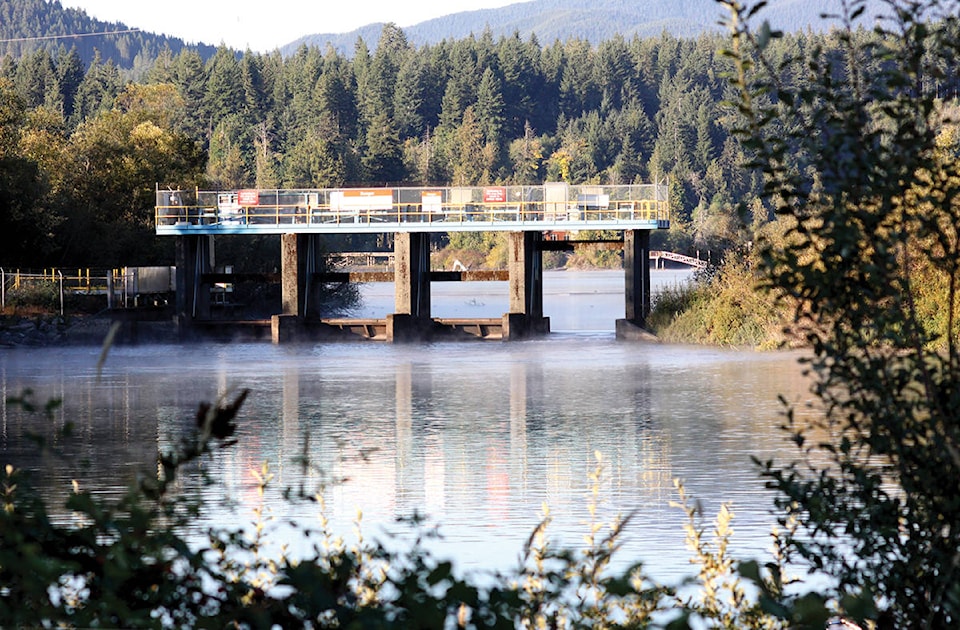Federal and provincial authorizations have been received by Catalyst Paper to gradually reduce the flow of water from Cowichan Lake into the Cowichan River during the next few days amid ongoing warm weather and drought conditions.
The company that operates the Crofton mill and relies on the river water for its operations will drop the level of water through the weir from seven cubic metres per second to 6.5 cms on Wednesday and a further 0.5 cms the next two days to 6.0 cms Thursday and then 5.5 cms by Friday afternoon.
“We go very slow because of the fish in the river that could be impacted,” said Brian Houle, environment manager for Catalyst Paper. “It would be wonderful if that was as low in the flow reduction as we need to go.”
The flow will be controlled at 5.5 cms and will only go down to 4.5 cms if the lake level drops into what’s known as the orange zone.
Many teams are out on the river volunteering with the stewarding of flow reductions, Houle added.
As dry weather continues and there’s no rain in the forecast for quite some time, the reductions will prevent the lake from dropping to a scarce level during traditionally dry August. But rain will be needed to make sure a crisis is averted in September.
“We’ve got enough water to get into September,” said Houle. “It’s getting through September that’s in question at this moment. We just can’t predict what Mother Nature is going to dish out to us.”
Applications to federal and provincial regulators were sent on July 16 about the risk of not enough water in the lake. Federal authorization arrived late last week and provincial approval was just received Monday.
Cowichan Tribes was quick to green light the process as well.
Houle noted as part of the authorizations, Catalyst is required to have qualified environmental people monitoring and managing the impacts on the river and specifically on the fish in the river.
“A key activity during ramping down of river flow is to ensure stranding of small fish is managed,” he added. “If fish are being cut off from access to the main stem of river, salvage activities help relocate these fish.”
As the flow settles in at 5.5 cms, Houle indicated, the resulting slower rate of decline in the level of the lake will help bring confidence to predictions of when pumping is expected to be needed or not required.
Some incorrect information is circulating online about Catalyst and water use, Houle pointed out, and he felt compelled to clarify accurate water use data for the mill.
“Catalyst has flow measurement for the water it extracts from the Cowichan River and had achieved its lowest extraction rate of 1.4 cubic meters per second cms in 2016,” he pointed out. “Since 2016 Catalyst has withdrawn from 1.5 to 1.6 cms of river water from the Cowichan. Catalyst has a licence authorizing the withdrawal of a maximum of 2.832 cms and withdraws just 56 per cent of licence allowance. Catalyst also has strict licence language that ensures the river below the mill pump station retains at least 2.832 cms of river flow. The mill must reduce operations if conditions cannot support the required river flow below the pump station.
“Catalyst also understands that the water it withdraws from the Cowichan River is water that is prevented from flowing the last 20 per cent of the river and that the mill use of water impacts the final 20 per cent of the river due to this withdrawal of water. From flow charts that predate the weir, 2021 is a year when the river flow would naturally decline and likely all the way to below one cms as was seen in a 1915 flow chart. The presence of the weir ensures a much higher flow in the river and the presence of the mill results in some of the water that is released is available for the mill to operate.”
The Catalyst mill is into water saving mode as the flow reductions move below 7 cms.
“The mill needs to use less water,” Houle conceded. “It’s at times like this the focus really does come and the will to use less water.”
Such actions as shutting down the automobile rinse station and instructing all workers to use water more sparingly are being undertaken immediately.
“We will make sure we engage and guide our employees that we don’t waste water,” Houle emphasized.
Teamwork from all stakeholders connected to the river will ensure the right steps are taken.
“Everybody on the lake is rowing in the same direction,” said Houle. “We all want the same thing.”



